-
Car Reviews
- All reviews
- Midsize SUVs
- Small cars
- Utes
- Small SUVs
- Large SUVs
- Large cars
- Sports SUVs
- Sports cars
- Vans
Latest reviews
- Car News
-
Car Comparisons
Latest comparisons
- Chasing Deals
While many businesses are still wary of electric vehicles, ignoring vans like the Ford E-Transit could be to miss out on an enticing product – though it comes at a heft cost
It came as somewhat of a surprise when Ford first announced back in 2021 that its E-Transit full-size van would be the first fully electric vehicle from the Blue Oval brand, but in hindsight, it doesn’t seem strange at all.
The E-Transit goes on sale imminently and will be followed up later this year by the E-Transit Custom midsize van and Mustang Mach-E midsize SUV, before a fully-electric Puma small SUV and potentially a plug-in hybrid Ranger ute follows before the end of 2024.
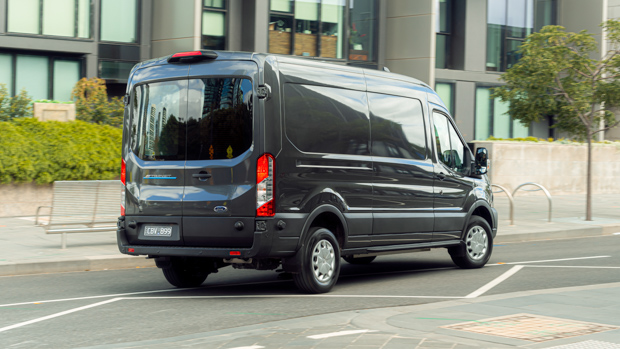
Given the widespread understanding – true or otherwise – that electric vehicles are hindered significantly when placed in commercial applications, vans might seem like an odd choice for electrification. Not so, says Ford.
Market research from the brand’s customers says that, on average, its customers only travel 115km per day – putting a typical use case comfortably inside the 230-307km WLTP-tested claim for the mid-roof E-Transit or 222-295km range for the high-roof option.
With this in mind, the E-Transit aims to offer no major drawbacks over its combustion counterpart, bolstered by the fact that there is no change to the loading space. In short, Ford believes it packs more than enough capability to be a genuine workhorse.
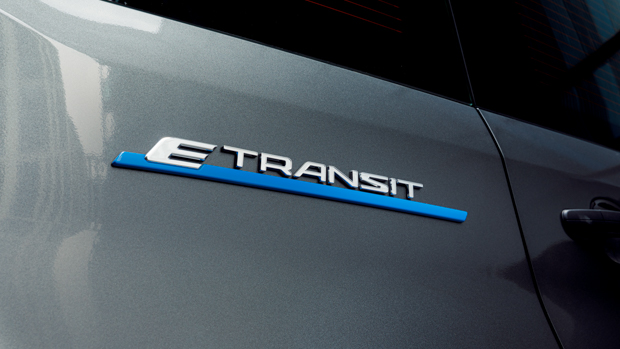
However we can’t forget the matter of price, and the E-Transit has a big one – starting from $104,990 before on-roads – which is a 81 percent hike over the cost of a similarly specced, diesel-powered Transit 350L auto ($57,990).
At that price, you can forget about any rebates from the state or federal government though if electric commercial vehicles being priced at six figures is set to become the norm in the immediate future, we hope we see some policy change from above in the future.
That price difference is a big pill to swallow, especially considering you aren’t actually gaining a whole lot in terms of outright capability – or are you?
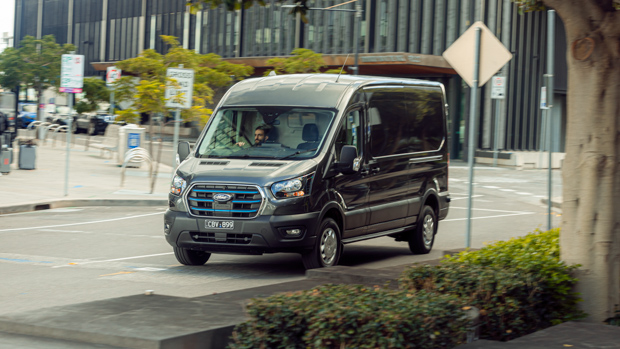
Electric vans have quickly become one of the most populated segments for electric vehicles, with E-Transit to face direct competition from LDV’s pricer eDeliver 9 (from $116,537 before on-roads) and Mercedes-Benz says it will introduce an electrified Sprinter to Australia when the next generation arrives in 2024.
If you’re willing to downsize there’s even more on offer, with the Peugeot E-Partner, Renault Kangoo and Volkswagen ID Buzz Cargo all coming to Australia in the near future.
And it’s hardly surprising. The year is 2023 and government legislation, along with the public sentiment, is shifting rapidly towards offering financial incentives to businesses who choose to go all-electric – or perhaps even penalties for those who don’t.
While the regular diesel-powered Transit is available in a litany of choices including van, bus and cab-chassis configurations, Ford has kept the lineup for the E-Transit very simple.
A single grade will be offered at launch known as the 420L mid roof, with the 420L high roof available as an option for an extra $1500.
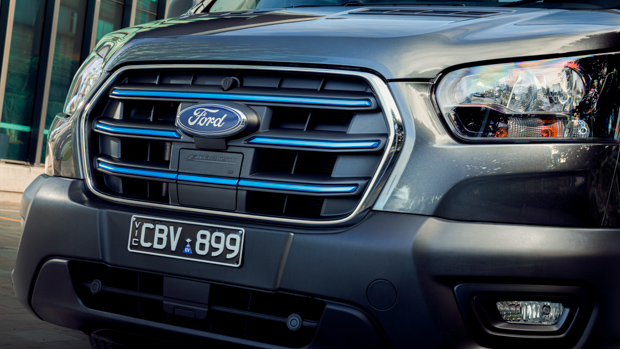
For the price, the E-Transit is sold with a standard three-seat configuration with the following features:
Those who would rather just two seats up front can add this option for an extra $150 and dual-sliding doors on either side of the cargo area will set buyers back an extra $1000.
Prestige paint options cost an extra $700 or if you want a broader range of choices you can tap into Ford’s Special Vehicle options selection that offers a choice of over 100 shades for $1400.
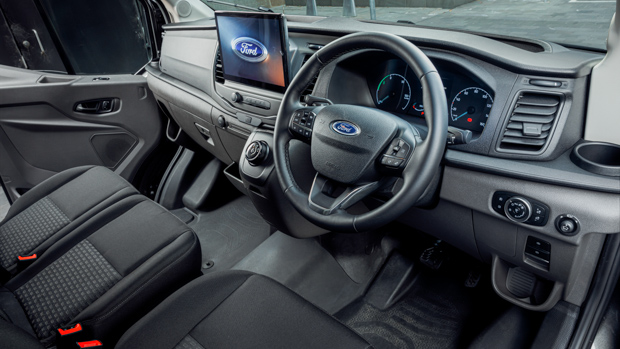
The list of features is short but meaningful and ultimately this is a van designed to meet the brief and do so at minimal cost.
It would be nice to see more cab-chassis and bus variants made available as they are for diesel-power Transits, however, Ford Australia has said they are focusing on the van variant for now as it will pull in the most sales volume.
I’ve spent a bit of time in vans as of late and as charming as the strong and smooth modern diesel engines can be, its immediate absence in the E-Transit was undoubtedly an improvement.
If this was a vehicle you’re going to be driving every day it’s not an exaggeration to say that the absence of this noise and vibration could bring a genuine improvement to your stress levels and mental wellbeing.
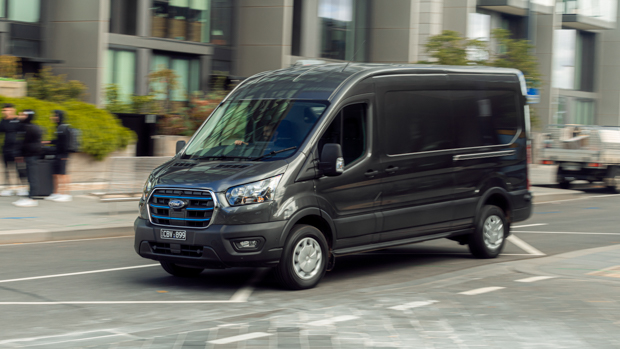
It might sound a bit flowery to say but research has shown countless times that excessive NVH can wear you down physically and mentally over time and the transition from diesel to electric might be the most pronounced in vans, where cabins are typically poorly insulated from the elements.
The low-end torque of both the diesel and electric drivetrains make the E-Transit a familiar vehicle to drive, and the fact that the electric variant retains rear-wheel drive adds to this.
When taking off from the lights it’s very apparent that Ford has flattened the instant torque curve of the 195kW/430Nm electric motor, but give it a second and the grunt soon draws you into the horizon with a comforting surge, just like a diesel.
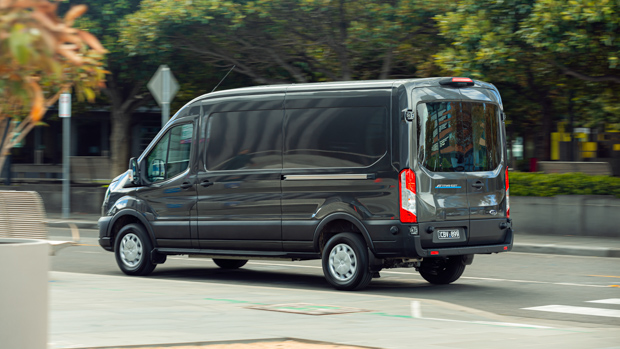
Ford has armed the E-Transit with three fairly self-explanatory driving modes: eco, normal and slippery.
Normal mode is of course the default and what we spent much of our time in during our test, whereas slippery puts traction control into overdrive and will no doubt come in handy driving the unladen van with hot-hatch levels of torque in the rain.
Eco mode makes outright driving range the priority, saving eight to ten percent more energy (says Ford) by trimming factors such as acceleration and top speed while also optimising the air conditioning use. In our testing, the effect was noticeable but not overly restrictive.
While we’re talking about top speed, it’s worth noting that the E-Transit is actually capable of reaching Australian highway speeds, unlike its LDV eDeliver 9 rival, which refuses to go beyond 90km/h.
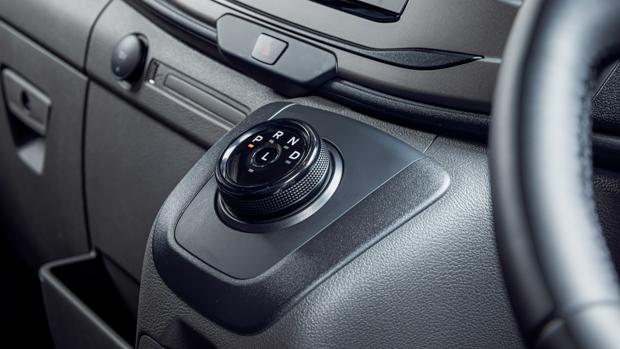
Ford offers two levels of regenerative braking, the default and a more intense setting when you select ‘L’ or Low mode, which mimics engine braking. While the latter will be handy for steep descents, it doesn’t offer a true ‘one pedal’ driving mode.
In recent years, the blue oval brand has progressed at a rapid rate when it comes to arming its vehicle lineup with electric drivetrains and much of that is down to parts sharing.
The platform on which the E-Transit sits is an adapted version of the monocoque design used for the regular Transit, with the electric battery and motor taken straight from the Mustang Mach-E, which we’ll see in Australia later this year.
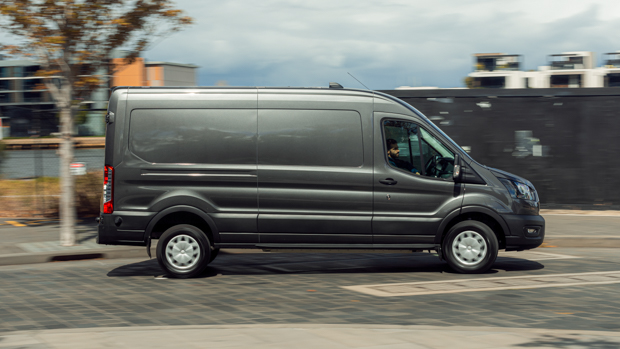
What is new, however, is the rear suspension, with Ford swapping out the live axle-leaf sprung design in the regular Transit for an all-in-one rear subframe unit that consists of the electric motor and independent suspension, just like in the F-150 Lightning sold in The States.
While we only had a chance to drive the E-Transit unladen during our time behind the wheel, the experience was relatively comfortable and controlled, which can’t always be said for leaf-sprung van alternatives.
Measuring 5981mm long, the E-Transit is a big beast but I’m a firm believer that a large vehicle isn’t a huge detriment most of the time – as long as you can see out of the bloody thing.
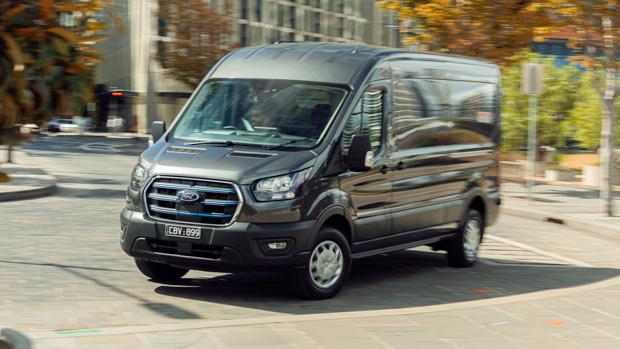
Huge mirrors, tall windows, a high seating position and an aquarium-sized piece of glass in front of you take care of the front and side visibility with the rear camera largely taking care of everything behind you.
It’s a good mix, but at this price point and size, I think a 360-degree view camera should be expected, as I saw on the Hyundai Staria Load Premium recently.
Finally, if you want to tow anything, the E-Transit won’t be for you as Ford has chosen to leave its electric van unrated globally but believes this won’t be an issue for most buyers.
It’s an interesting move considering that the electric Ford F-150 Lightning has been shown to confidently tow up to 4.5 tonnes.
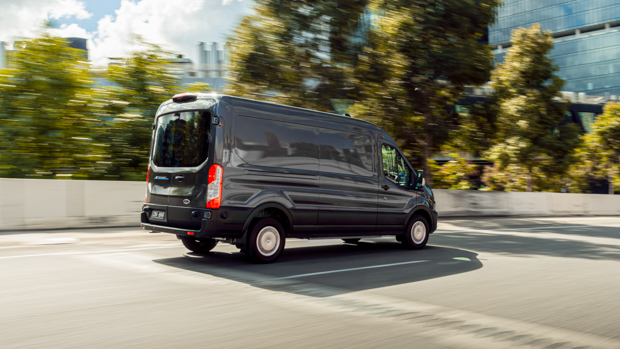
However, the significant penalty to the driving range seen by US press outlets and buyers while doing so may be one clue as to why the E-Transit has been left unrated.
It remains to be seen as to what degree testing the limits of the E-Transit’s payload has to its real-world range capabilities.
Ford’s mission to get the E-Transit on the road as quickly as possible means the interior has been left largely the same as its combustion derivative and that’s no bad thing.
Harsh plastic materials are everywhere, but so they should be in this sort of vehicle; providing the sort of durability that buyers will need. It’s a pity Ford can’t make some of this plastic less shiny though, as it’s a menace to the eyes when it catches the sun at the wrong angle.
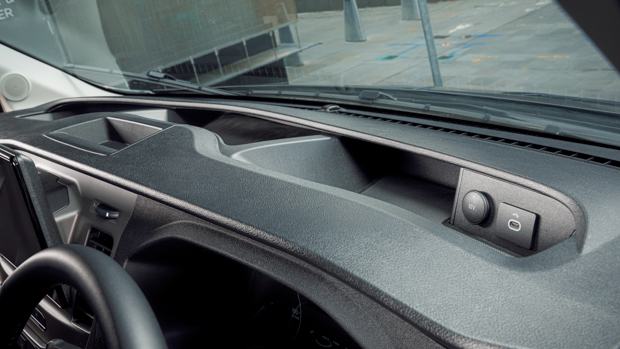
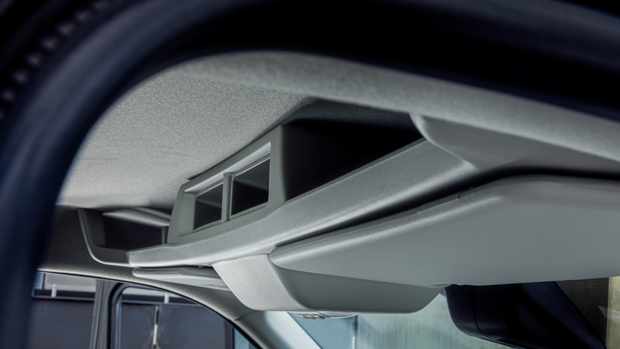
The 2+1 seating layout features heating underneath along with a plethora of water bottle and cup holders, plus modern USB-C outlets and ample storage both overhead and on the dash for all your paperwork and/or discarded pie wrappers.
The 12.0-inch touchscreen sitting in the centre runs off Ford’s latest Sync 4 operating system. It’s far more modern and powerful than Sync 3 that most Ford van owners will be familiar with and it also brings niceties such as wireless functionality for Apple CarPlay and Android Auto.
It’s not just useful for tunes either, as Ford’s connected services – and more specifically FordPass Power My Trip – can be genuinely very useful.
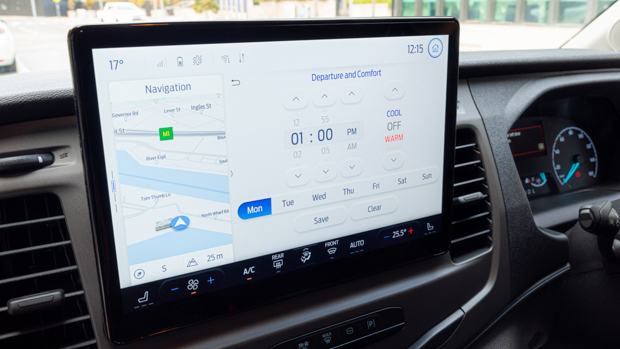
The aforementioned software allows drivers to enter a destination, via their phone on the FordPass app if they so wish, and will calculate route suggestions based on the E-Transit’s state of charge and suggest chargers along the way, while taking into consideration how long it will take to charge.
Be careful though, as the system runs on a series of databases including PlugShare and won’t take into consideration things such as the sheer height of your vehicle (up to 2790mm in the high roof) and there is always the possibility some muppet will jump in your charging bay of choice while you’re in route.
Drivers can also schedule the E-Transit to pre-condition the battery before they set off, allowing the power unit to heat or cool the battery to ideal conditions when plugged in, so it can operate more efficiently once on the move.
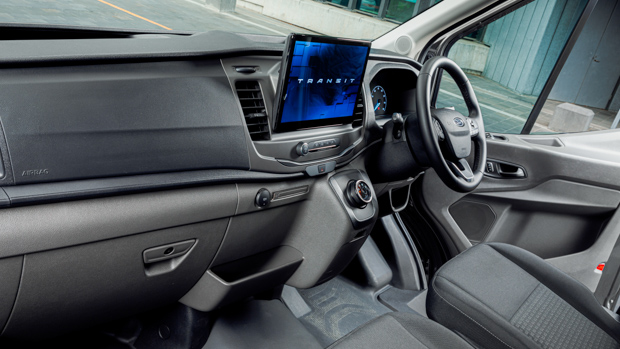
Okay, but what about, you know, carrying things? Well, a major bragging point of the E-Transit is that, despite having a big 68kWh battery under the floor, there has been no compromise in terms of load space in comparison to the Transit 350L RWD.
The mid-roof has a rated carrying capacity of 11m3 of space or 12.4m3 in the high roof, drawing roughly even with the LDV eDeliver 9 in its respective sizes.
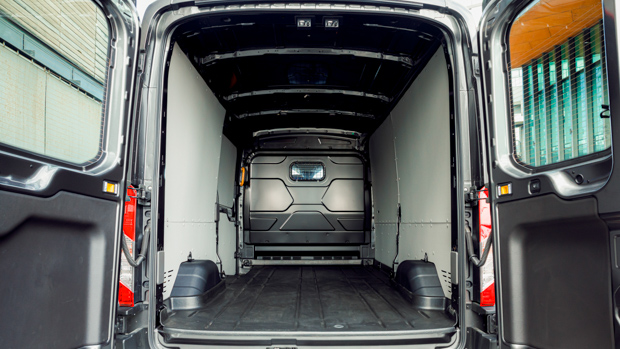
In terms of payload, the E-Transit is rated at 1611kg and 1566kg for the mid- and high-roof respectively, which are both up on the 1142kg quoted for the Transit 350L RWD auto with the standard roof.
Standard features back here include hard-wearing plastic flooring, removable side protection on the walls and a 2.3kW house-style three-pin socket to power your tools or other items.
Disappointingly, the current-generation Transit van does not currently carry an official ANCAP safety rating, and at the time of publication, the same is true for the E-Transit variant.
This is a disappointing trend among the commercial vehicle segment and one that ANCAP has been vocal about in the past, however, the E-Transit comes with the same long list of active safety equipment just like the rest of the Transit range.
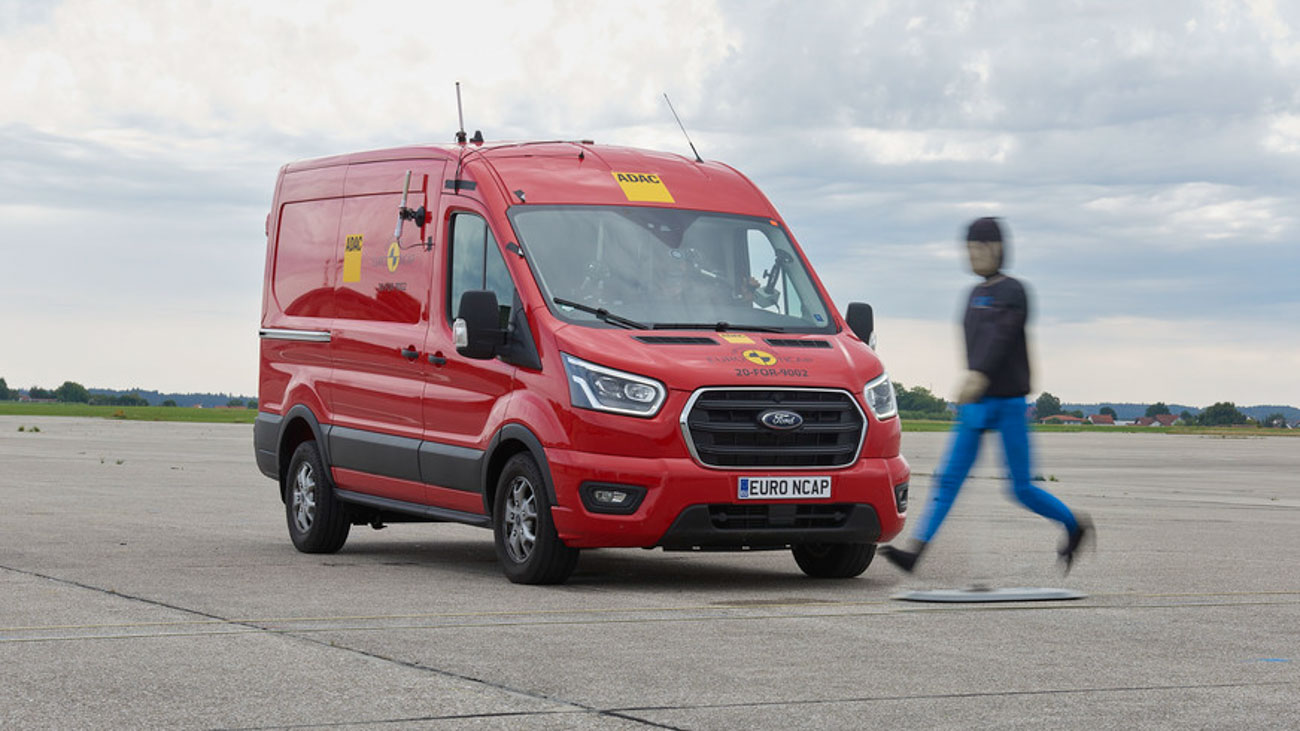
This includes:
ANCAP recently tested the effectiveness of the Transit’s active safety features against the competition and it scored an impressive second place with a 63 percent rating – though there was daylight between it and the Fiat Ducato, in first place with a whopping 88 percent rating.
After you’ve taken a deep breath and swallowed the $47,000 premium over the comparable diesel, it will come as a welcome surprise that the E-Transit is rather affordable to run.
Based on Ford’s WLTP-tested range claim of 230km to 307km from the 68kWh usable capacity, the E-Transit should see an efficiency of between 29.6 to 22.2kWh/100km.
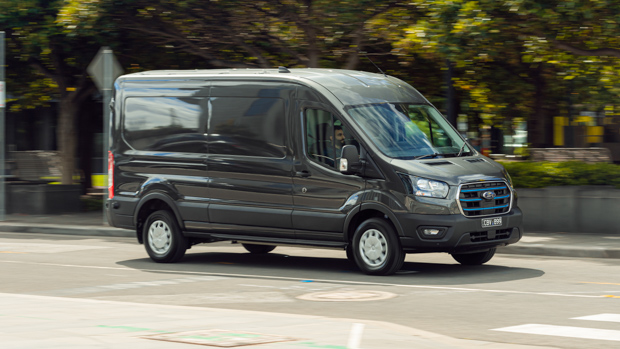
Ford says this rating doesn’t include any cargo, which it claims will only have a marginal effect on outright range, but this unladen figure does seem to be on the money as in our testing we saw an average consumption of 23kWh/100km.
Most importantly, this is substantially more efficient than the mid-roof, long-range variant of the LDV eDeliver 9, which quotes an average consumption of 33.9kWh/100km, and this is despite having a bigger 88.5kWh battery, resulting in a shorter maximum range of 280km.
But how does it stack up against the diesel? Well for this hypothetical, let’s assume a mixture of cheap off-peak depot charging and more expensive public charging bringing us to an average figure of $0.40 per kWh.
We were shown research provided by Ford that stated an average commercial van operator drives about 115km per day – and there are about 250 working days per year here in Australia.
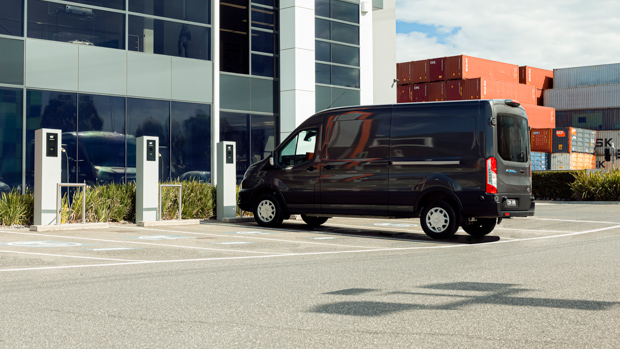
If you can match our tested E-Transit energy efficiency of 23.0kWh/100km, that’s a cost of about $10.60 per day in charging – or $2650 across 250 working days per year.
How does that compare to the cost of running the equivalent diesel Transit 350L RWD? Oddly, Ford doesn’t publish fuel economy figures for that vehicle, but working with an educated guess of 10.0L/100km across the same time and distance yields a working year spend of $5750.
That makes fuelling the electric E-Transit about $3100 cheaper every year. But because it’s more expensive to buy by $47,000, you’d have to run the E-Transit for over 15 years in order to break even – though that’s before you consider the refinement and environmental benefits.
However, it’s worth considering that Australia will see the introduction of fuel efficiency standards as early as 2023 and this policy could help close this gap.
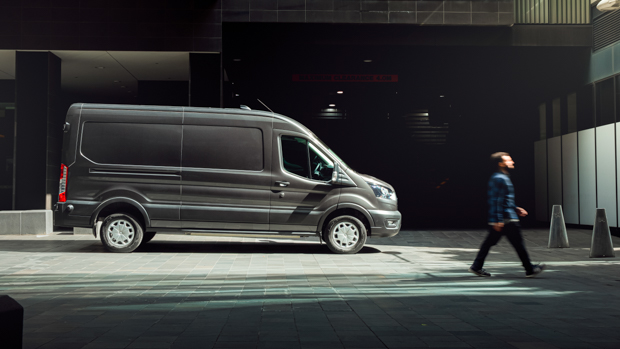
While heavy vehicles are being left off the scheme for now and we still don’t know the full details, it’s feasible that we could see big emitting vehicles penalised per kilometre driven in the coming years.
In terms of charging, Ford says a maximum DC charging speed of 115kW can see the E-Transit topped up from 15 per cent to 80 percent in around 34 minutes or recharged from flat to full in 8.2 hours using an 11kW AC charger.
Ford has backed the E-Transit with an industry-standard five-year, unlimited-kilometre warranty with a separate eight-year, 160,000-kilometre warranty applied to the battery and electric drivetrain.
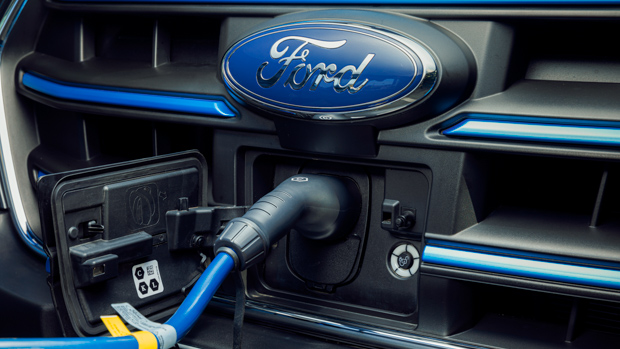
That timeline will be comforting to business owners, with Ford guaranteeing that at least 70 percent of the battery will remain during this period, though the brand says in-house testing suggests it will clear this margin easily.
Service intervals for the E-Transit are the same as the diesel at 12 months or 30,000km. However, at the time of publishing this review, Ford has not disclosed how much the E-Transit will cost to service.
There is arguably no greater test for revolutionary drivetrain technology than plonking it in a commercial vehicle where it will be driven hard day in, day out, for years to come. So Ford knows they need to get this right.
The blue oval brand is banking on extensive testing that shows that the E-Transit’s hardware doesn’t just perform in the real world but lasts for the long haul.
We really hope they’re right, and not just for the environmental benefits but because the E-Transit is a genuine step forward for the commercial van segment that should offer enough baseline capability for most buyers without the drawbacks of a diesel.
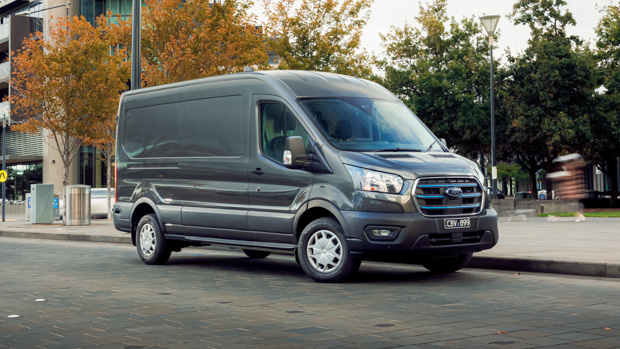
However the astronomical jump in price from the oil burner is a hurdle that will require some justification beyond just the raw numbers, such as the desire to convert your fleet to green energy or seeking an improvement over reliable but noisy and unrefined diesel engines.
You can’t put a price on silence, as they say.
Ultimately it will be up to you and what you’re comfortable putting your money behind but vans are often a long-term investment and at a time when Australia is looking to play catch up with the emissions standards seen elsewhere in the developed world, perhaps the heavy-emitting diesel isn’t as safe a bet as it once was.
About Chasing cars
Chasing Cars reviews are 100% independent.
Because we are powered by Budget Direct Insurance, we don’t receive advertising or sales revenue from car manufacturers.
We’re truly independent – giving you Australia’s best car reviews.
The estimate provided does not take into account your personal circumstances but is intended to give a general indication of the cost of insurance, in order to obtain a complete quote, please visit www.budgetdirect.com.au. Estimate includes 15%^ online discount.
^Conditions Apply
Budget Direct Insurance arranged by Auto & General Services Pty Ltd ACN 003 617 909(AGS) AFSL 241 411, for and on behalf of the insurer, Auto & General Insurance Company Limited(ABN 42 111 586 353, AFSL 285 571).Because we don’t know your financial needs, we can’t advise you if this insurance will suit you. You should consider your needs and the Product Disclosure Statement before making a decision to buy insurance. Terms and conditions apply.
Indicative quote based on assumptions including postcode , 40 year old male with no offences, licence suspensions or claims in the last 5 years, a NCD Rating 1 and no younger drivers listed. White car, driven up to 10,000kms a year, unfinanced, with no modifications, factory options and/or non-standard accessories, private use only and garaged at night.
^Online Discounts Terms & Conditions
1. Discounts apply to the premium paid for a new Budget Direct Gold Comprehensive Car Insurance, Third Party Property Only or Third Party Property, Fire & Theft Insurance policy initiated online on or after 29 March 2017. Discounts do not apply to optional Roadside Assistance.
2. Discounts do not apply to any renewal offer of insurance.
3. Discounts only apply to the insurance portion of the premium. Discounts are applied before government charges, taxes, levies and fees, including instalment processing fees (as applicable). The full extent of discounts may therefore be impacted.
4. We reserve the right to change the offer without notice.